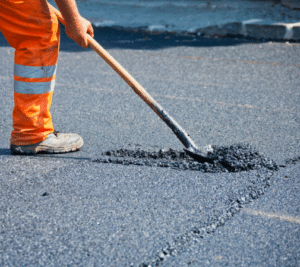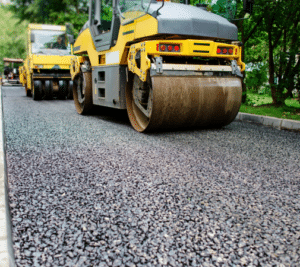Have you ever wondered: why does concrete crack? Despite its strength and durability, concrete is prone to developing cracks over time. Whether you’ve noticed cracks in your driveway, sidewalk, or even in large concrete structures, understanding the reasons behind this phenomenon can help you prevent and address future cracks. So, let’s dive into the fascinating world of concrete and explore why it cracks.
What Is Concrete?
Concrete is a versatile and widely-used construction material renowned for its strength and durability. It is a mixture of cement, aggregates such as sand and gravel, and water. When these ingredients are combined, a chemical reaction called hydration occurs, which causes the mixture to harden and become solid.
The cement acts as a binder for the aggregates, holding them together to create a solid mass. As the concrete hardens, it becomes a strong, sturdy material that can withstand heavy loads and pressures. This makes it ideal for various applications, including building foundations, roads, bridges, and decorative elements.
The strength of concrete is measured in terms of its compressive strength, which is the maximum amount of force it can bear before it begins to crack or fail. The compressive strength of concrete is usually expressed in pounds per square inch (psi).
Concrete is a porous material, meaning it contains small interconnected voids that allow air and water passage. While this porosity can be minimized through proper curing techniques and additives, it remains a characteristic of concrete. This porosity makes concrete susceptible to cracking, especially when subjected to certain conditions or forces.
In the following sections, we will explore the common causes of concrete cracking and the various types of cracks that can occur. By understanding these factors, we can better comprehend why concrete cracks and how to prevent or address this common issue in construction projects.
Why Does Concrete Crack?
1. Shrinkage: Concrete shrinks as it cures due to water loss from its pores. This shrinkage can cause stresses in the concrete that lead to cracks forming as it contracts.
2. Overloading: If a structure is subjected to more weight or force than it was designed for, this can cause concrete elements to crack or fail due to overload.
3. Thermal Changes: Temperature changes can also cause concrete to crack due to the expansion and contraction of the material as it heats up or cools down. This is especially true when there are large temperature fluctuations in a short period, such as during a cold winter night or hot summer day.
4. Freeze-Thaw Cycles: When water gets trapped inside concrete pores and then freezes, it causes the pores to expand. This expansion can cause the concrete to crack as the trapped moisture expands, putting pressure on the material.
5. Poor Construction Practices: If concrete is not properly mixed, placed, cured, or reinforced, this can lead to cracks forming due to weak points in the material. Improper curing techniques or a lack of reinforcing steel can also contribute to concrete cracking.
6. Inadequate Compaction: If the concrete is not compacted correctly before it hardens, then there may be voids in the material, leading to cracking. This is because these air pockets cannot withstand the same pressure as other parts of the concrete, making them more prone to cracking when subjected to external forces.
7. Chemical Attack: Certain chemicals or compounds can break down the cement particles in concrete, leading to cracks forming. Acids and alkalis are the most common culprits of chemical attacks, as they can corrode the cement matrix and weaken it.
8. Poor Drainage: If the concrete is constantly exposed to water, either from natural sources such as rain or an irrigation system, this can cause cracking due to the hydrostatic pressure of the water. This is why it is important to ensure that any concrete structures are built on a proper drainage system that allows excess moisture to be quickly removed.
9. Subsidence: If the soil beneath the concrete begins to settle or shift due to a variety of factors, this can cause the concrete to crack as it adjusts to the new ground levels. This is why it is essential to ensure that any soil conditions are adequately addressed before pouring concrete.
10. Improper Curing: If concrete is not cured correctly, this can lead to cracks forming due to the material not having enough time to harden and strengthen properly. This is why following all curing instructions related to your concrete project is essential to ensure that it is correctly cured and that these types of cracks are avoided.
11. Incorrect Joints: Expansion and control joints allow concrete to expand and contract with changes in temperature without cracking. If these types of joints are not included or are incorrectly placed, this can lead to cracking due to the pressure that builds up between concrete sections.
Types of Cracks in Concrete
Cracks in concrete can come in various forms, each indicating a different underlying issue. Understanding the different types of cracks can help identify the cause and determine the appropriate course of action for repair. Let’s delve into the most common types of cracks in concrete:
1. Hairline Cracks: Hairline cracks are thin, barely visible to the naked eye. They are commonly caused by shrinkage during the drying and curing process of concrete. While hairline cracks are typically harmless, they can sometimes develop into larger cracks over time if left untreated.
2. Plastic Shrinkage Cracks: Plastic shrinkage cracks typically occur when fresh concrete is exposed to hot and dry conditions. These cracks appear shortly after pouring and resemble irregular patterns or shallow fissures on the surface. Rapid moisture loss due to high evaporation rates is the leading cause of plastic shrinkage cracks.
3. Settlement Cracks: Settlement cracks generally occur in concrete foundations and slabs. These cracks result from uneven soil compaction or improper reinforcement during construction. As the soil beneath the concrete settles or shifts, it creates stress on the structure, leading to cracks.
4. Expansion Cracks: Expansion cracks are caused by the expansion of concrete due to temperature changes. In hot weather, concrete expands, while in cold weather, it contracts. Without sufficient room to expand or contract, the stress can cause cracks to form. Installing expansion joints helps accommodate these movements and minimizes the risk of cracking.
5. Crazing Cracks: Crazing cracks appear as a network of fine cracks on the surface of cured concrete. They are typically shallow and do not penetrate deep into the structure. Crazing often occurs due to surface shrinkage caused by overworking or improper curing techniques. While they are more common in decorative concrete, they can also affect structural elements.
6. Structural Cracks: Structural cracks are a cause for concern as they indicate potential issues with the integrity of the concrete. These cracks can vary in width and depth, and they may develop due to excessive weight or load on the structure, inadequate reinforcement, or poor construction practices. It is crucial to address structural cracks promptly to prevent further damage.
To ensure the proper diagnosis and repair of concrete cracks, consulting with an experienced concrete contractor is essential. They can assess the type and severity of the cracks and recommend the most suitable repair method, which may include epoxy injection, crack stitching, or complete replacement of the affected concrete.
Preventing cracks in concrete requires following proper construction practices, including using control joints and expansion joints, proper curing techniques, and the appropriate water-to-cement ratio during the mixing process. By taking preventive measures and addressing cracks promptly, you can maintain the structural integrity and longevity of your concrete projects.
If you’re in need of concrete contractor services to fix a crack in an existing concrete foundation or need new concrete laid, give us a call at Saguaro Asphalt! Our team can tackle any concrete job, big or small.



